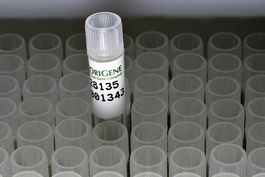Atp5h (NM_027862) Mouse Tagged ORF Clone
CAT#: MR201260L3
- LentiORF®
Lenti ORF clone of Atp5h (Myc-DDK-tagged) - Mouse ATP synthase, H+ transporting, mitochondrial F0 complex, subunit d (Atp5h), nuclear gene encoding mitochondrial protein
"NM_027862" in other vectors (4)
Interest in protein/lysate? Submit request here!
Product Images

Specifications
| Product Data | |
| Type | Mouse Tagged ORF Clone |
| Tag | Myc-DDK |
| Symbol | Atp5h |
| Synonyms | 0610009D10Rik; Atp5pd |
| Vector | pLenti-C-Myc-DDK-P2A-Puro |
| E. coli Selection | Chloramphenicol (34 ug/mL) |
| Mammalian Cell Selection | Puromycin |
| Sequence Data |
The ORF insert of this clone is exactly the same as(MR201260).
|
| Restriction Sites | SgfI-MluI Cloning Scheme for this gene |
| ACCN | NM_027862 |
| ORF Size | 486 bp |
| OTI Disclaimer | The molecular sequence of this clone aligns with the gene accession number as a point of reference only. However, individual transcript sequences of the same gene can differ through naturally occurring variations (e.g. polymorphisms), each with its own valid existence. This clone is substantially in agreement with the reference, but a complete review of all prevailing variants is recommended prior to use. More info |
| OTI Annotation | This clone was engineered to express the complete ORF with an expression tag. Expression varies depending on the nature of the gene. |
| Reference Data | |
| RefSeq | NM_027862.1, NP_082138.1 |
| RefSeq Size | 574 |
| RefSeq ORF | 486 |
| Locus ID | 71679 |
| Gene Summary | Mitochondrial membrane ATP synthase (F(1)F(0) ATP synthase or Complex V) produces ATP from ADP in the presence of a proton gradient across the membrane which is generated by electron transport complexes of the respiratory chain. F-type ATPases consist of two structural domains, F(1) - containing the extramembraneous catalytic core, and F(0) - containing the membrane proton channel, linked together by a central stalk and a peripheral stalk. During catalysis, ATP synthesis in the catalytic domain of F(1) is coupled via a rotary mechanism of the central stalk subunits to proton translocation. Part of the complex F(0) domain and the peripheric stalk, which acts as a stator to hold the catalytic alpha(3)beta(3) subcomplex and subunit a/ATP6 static relative to the rotary elements. [UniProtKB/Swiss-Prot Function] |
Documents
| Product Manuals |
| FAQs |
| SDS |
Resources
Other Versions
| SKU | Description | Size | Price |
|---|---|---|---|
| MC202480 | Atp5h (untagged) - Mouse ATP synthase, H+ transporting, mitochondrial F0 complex, subunit d (Atp5h), nuclear gene encoding mitochondrial protein, (10ug) |
USD 210.00 |
|
| MR201260 | Atp5h (Myc-DDK-tagged) - Mouse ATP synthase, H+ transporting, mitochondrial F0 complex, subunit d (Atp5h), nuclear gene encoding mitochondrial protein |
USD 68.00 |
|
| MG201260 | Atp5h (GFP-tagged) - Mouse ATP synthase, H+ transporting, mitochondrial F0 complex, subunit d (Atp5h) |
USD 300.00 |
|
| MR201260L4 | Lenti ORF clone of Atp5h (mGFP-tagged) - Mouse ATP synthase, H+ transporting, mitochondrial F0 complex, subunit d (Atp5h), nuclear gene encoding mitochondrial protein |
USD 500.00 |
{0} Product Review(s)
Be the first one to submit a review






























































































































































































































































 Germany
Germany
 Japan
Japan
 United Kingdom
United Kingdom
 China
China

